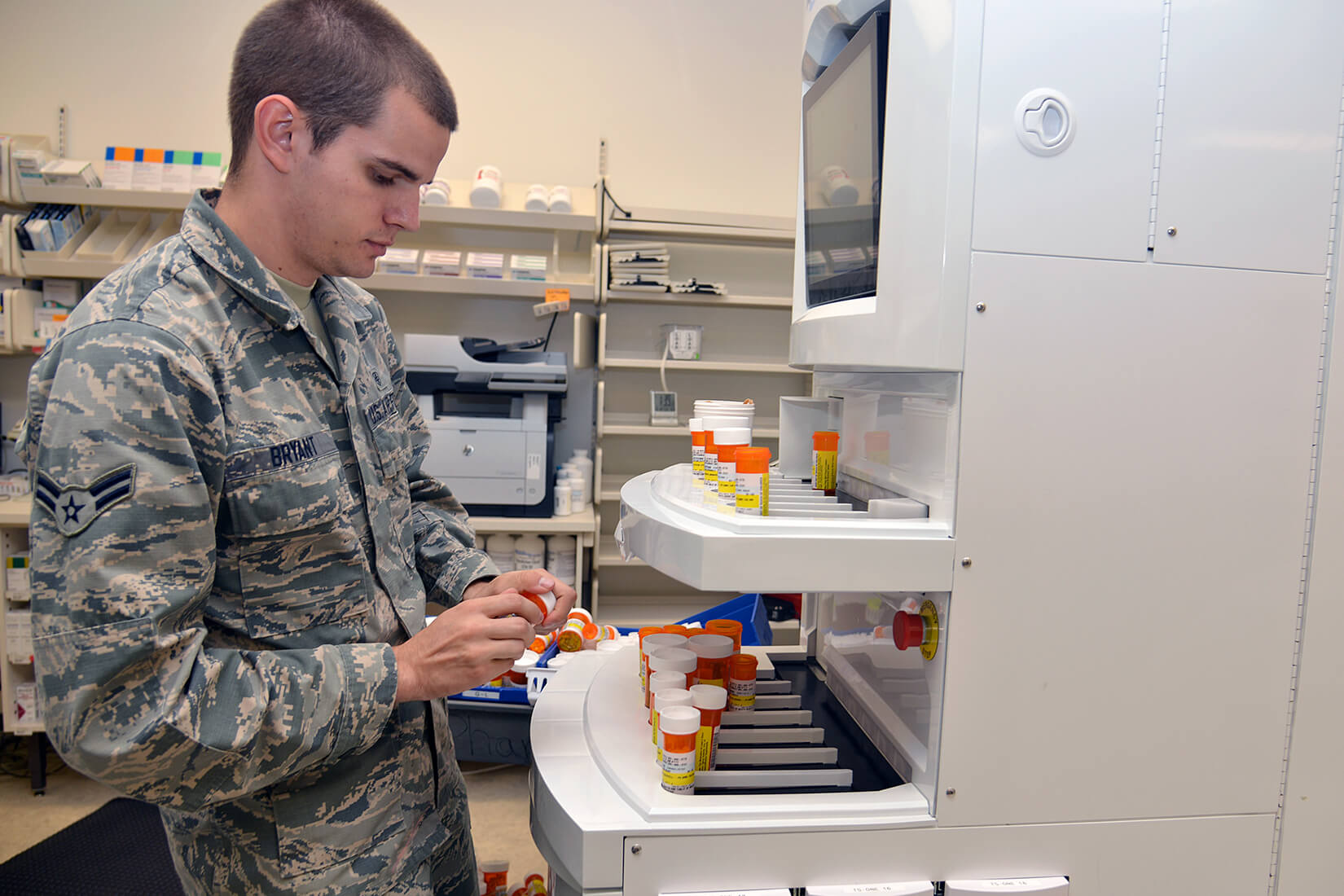 Airman 1st Class Joseph Bryant, 377th Medical Support Squadron, checks prescriptions processed by the robotic automation system at the Kirtland Air Force Base, NM. Photo by Todd Berenger
Airman 1st Class Joseph Bryant, 377th Medical Support Squadron, checks prescriptions processed by the robotic automation system at the Kirtland Air Force Base, NM. Photo by Todd Berenger
FALLS CHURCH, VA — As of January 2018, 54% of prescriptions filled by MTFs were submitted electronically, exceeding the initial goal of 50% set when the e-prescribing program first rolled out three years ago.
The program, which allows both military and civilian providers to send prescriptions electronically, now covers all military pharmacies in the United States, Guam and Puerto Rico.
“Any provider connected to a commercial electronic prescribing network may send an electronic prescription to an MTF pharmacy that is part of the ePrescribing network,” said Defense Health Agency (DHA) spokesperson Kevin Dwyer.
Now the goal is to “reach the commercial standard of 75% by continually educating TRICARE beneficiaries, providers and contractors of this capability,” he added.
Pharmacies and health systems across the country have embraced electronic prescribing for a variety of reasons. Electronic prescriptions reduce the risk of transcription errors or incorrectly filled prescriptions caused by illegible handwriting. The technology also means that pharmacy staff spend less time trying to reach physicians to clarify prescriptions, and it also provides a more convenient alternative for patients, who do not run the risk of losing a prescription or need to wait in line to drop off a prescription and answer questions about it and then return to pick up the medication.
By securely transmitting prescriptions directly to MTF pharmacies, “electronic prescribing can reduce MTF wait times and allows MTF pharmacy staff to resolve issues with prescriptions before the beneficiary arrives. Additionally, MTF pharmacies are the most cost-effective point of service for beneficiaries as they can get up to A 90-day supply of most medications for no copay or cost-share,” Dwyer told U.S. Medicine.
So far, servicemembers, other beneficiaries and military healthcare professional have warmed to the new system. “Electronic prescribing has been positively received by patients, providers and pharmacists,” Dwyer said. “The MHS continues to actively notify and educate patients and providers that electronic prescribing is available at MTF pharmacies” to drive increased adoption.
The electronic prescribing (eRx) program aligns the Military Health System with federal e-Prescribing Meaningful Use requirements and recognizes that an increasing number of civilian providers have switched to using electronic prescribing exclusively, according to the Military Health System. It also acknowledges that electronic prescriptions have become standard practice at civilian pharmacies, Dwyer added.
While the program improves pharmacy workflow by electronically receiving and processing civilian provider prescriptions, it did require some changes to processes. “However, minimal procedural and staffing changes were required for electronic prescribing, as the pharmacy system changes were integrated into existing workflow to minimize training and staffing disruptions,” according to Dwyer.
The electronic system mimicked the appearance of the format of the Composite Health Care System (CHCS) used within the MHS, which allowed the program to achieve efficiencies through familiarity, intuitive user interface and auto-matching capabilities, as well as the elimination of issues associated with handwriting and transcription.
Patients often experience less waiting with electronic prescriptions. “In general, electronic prescribing allows MTF pharmacies to receive prescription information before the patient arrives at the pharmacy and affords the MTF the option to fill prescriptions before the patient arrives,” he said. Most of the time, that means patients will have shorter wait times than with paper prescriptions. In some cases, prescriptions may not be filled in advance, depending on the pharmacy’s hours, workload, processes and procedures.
Some pharmacies tell patients up front that their medications will not be filled before they come to pick them up. A flyer for the Naval Medical Center San Diego’s Pharmacy Network, for instance, tells patients “The medication will not be filled until you arrive at the pharmacy of your choice. When you check in, tell the technician that your provider electronically prescribed your prescription.”
Dwyer said that while “military pharmacies stock drugs on the Basic Core Formulary as well as many brand name maintenance drugs on the Uniform Formulary, it is best to call the military pharmacy to verify that the drug requested is available.” If a drug is not in stock or not on the formulary, the pharmacy will work with the provider to find an alternative or suggest filling the prescription through home delivery or at a retail network pharmacy. Alternatively, most formulary drugs can be ordered and will be available for pick up the next business day. Physicians and patients can quickly see whether the TRICARE formulary includes a specific medication by reviewing the online pharmacy formulary.
While the electronic prescribing networks generally support electronic prescriptions for controlled substances, the specific solution used in military pharmacies is not certified to receive and process them, according to an MHS document on managing the eRx initiative. Consequently, military pharmacies still require hard copy or faxed prescriptions for all controlled substances. The Drug Enforcement Agency required hard copy or faxed prescriptions until 2010, when it enabled electronic prescriptions. By 2015, all 50 states had updated their laws on controlled substances to reflect the DEA change.
The MHS uses the largest national electronic prescribing network, which makes connecting to it easy for most civilian physicians accustomed to e-prescribing. They can search for the military pharmacy by using the DoD adopted naming standard “DoD SITE NAME ePhcy.” All MTF pharmacies that accept electronic prescriptions start with “DoD” and are published to the Surescripts electronic prescribing network.
